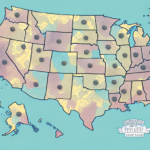Understanding UPS Shipping Drop-Off Rates
When it comes to shipping packages, one of the most important factors to consider is the shipping rates. Understanding UPS shipping drop-off rates is crucial for anyone who needs to frequently ship packages with the service. In this article, we will cover everything you need to know about UPS shipping drop-off rates and how to optimize your packaging and shipping process to save money.
How UPS Calculates Shipping Drop-Off Rates
UPS shipping rates are calculated based on a variety of factors, including:
- Weight and Size: The primary determinants of shipping cost. Packages that weigh less and are smaller in size generally cost less to ship.
- Destination: Shipping to farther destinations or international locations typically incurs higher costs.
- Shipping Speed: Faster shipping options, such as overnight delivery, are more expensive than standard shipping.
- Package Type: Special handling requirements or hazardous materials can add to the cost.
UPS uses dimensional weight pricing for larger packages, where the size of the package is used to determine its "weight" for pricing purposes. This means that very large but lightweight packages may cost more than smaller, denser packages.
For a comprehensive overview of how UPS calculates shipping rates, refer to their official rate calculation guide.
The Impact of Package Weight and Size on Shipping Rates
The weight and size of your package are critical factors influencing UPS shipping rates. To optimize your shipping costs:
- Use Smaller Boxes: Reducing the dimensional weight can significantly lower shipping costs for larger, lightweight packages.
- Consolidate Packages: Combine multiple smaller packages into one larger package to take advantage of bulk shipping rates.
- Lightweight Materials: Choose packaging materials that provide protection without adding unnecessary weight.
It's also important to distinguish between shipping to residential versus commercial addresses, as residential deliveries often require additional handling and can be more expensive.
Tips for Lowering Your UPS Shipping Drop-Off Rates
Implementing the following strategies can help reduce your UPS shipping drop-off rates:
- Optimize Package Size: Use appropriately sized boxes to minimize dimensional weight charges.
- Negotiate Rates: As a business owner, establishing a relationship with UPS can lead to discounted shipping rates.
- Utilize UPS Tools: Leverage the UPS shipping calculator to estimate costs and choose the most cost-effective shipping options.
- Efficient Packing: Use space-saving materials like bubble wrap or packing peanuts to reduce package size and weight.
For more detailed strategies, consider consulting UPS's Smart Shipping Solutions.
How to Compare UPS Shipping Rates with Other Carriers
To ensure you are getting the best deal, it's essential to compare UPS shipping rates with other carriers such as FedEx and USPS. Here's how:
- Use Pricing Tools: Online tools allow you to compare shipping rates based on your package's size, weight, and destination.
- Evaluate Delivery Times: Balance the cost with the required delivery speed to choose the best option.
- Assess Customer Service: Reliable tracking and responsive customer support are crucial for ensuring your packages arrive safely and on time.
Consider using comparison platforms like ShipStation or EasyPost to streamline the comparison process.
The Role of Distance and Destination in UPS Shipping Prices
Distance and destination significantly impact UPS shipping prices. Factors to consider include:
- Geographical Distance: Shipping over longer distances generally costs more.
- International Regulations: Different countries have varying customs and tariff requirements that can affect shipping costs.
When shipping internationally, ensure you are familiar with the destination country’s regulations to avoid delays and extra fees. Refer to UPS’s International Shipping Guide for detailed information.
Understanding the Different Types of UPS Shipping Services Available
UPS offers a variety of shipping services tailored to different needs:
- UPS Ground: Cost-effective with reliable delivery times, ideal for non-urgent shipments.
- UPS Next Day Air: Fastest delivery option for urgent shipments.
- UPS Freight: Suitable for larger, heavier shipments requiring freight services.
- UPS International: Comprehensive international shipping solutions with various delivery speeds.
Choose the service that best fits your shipping requirements and budget by reviewing UPS’s comprehensive shipping services.
How to Negotiate Better UPS Shipping Rates as a Business Owner
As a business owner, you can negotiate better UPS shipping rates by:
- Establishing a Relationship: Regularly shipping through UPS can make you eligible for discounted rates.
- Volume Discounts: Shipping larger volumes can qualify you for lower rates.
- Leveraging UPS Software: Tools like Worldship and Quantum View help monitor and manage shipping costs effectively.
Contact a UPS account manager to discuss potential discounts and tailor a shipping plan that suits your business needs.
The Importance of Accurate Package Measurements for Accurate Shipping Rates
Accurately measuring and weighing your packages is essential to ensure you are charged correctly for shipping:
- Use a Reliable Scale: Ensure precise weight measurements.
- Measure Dimensions Carefully: Accurate dimensions help avoid dimensional weight pricing discrepancies.
- Double-Check Information: Verify measurements before finalizing your shipment to prevent overcharges.
Using tools like the ShipStation Scale can help maintain accuracy in your shipping process.
Common Mistakes that Lead to Higher UPS Shipping Drop-Off Rates
Avoid these common mistakes to prevent higher UPS shipping drop-off rates:
- Incorrect Package Size: Using boxes that are too large increases dimensional weight charges.
- Poor Packaging: Inadequately secured packages may incur additional fees for special handling.
- Wrong Destination Information: Entering incorrect zip codes or addresses can lead to delays and extra costs.
- Neglecting to Compare Rates: Failing to compare rates with other carriers may result in overpaying for shipping.
Ensure meticulous attention to detail in your shipping process to avoid these costly mistakes.
How to Optimize Your Packaging for Lower UPS Shipping Costs
Optimizing your packaging can lead to significant savings on UPS shipping costs:
- Use Appropriately Sized Boxes: Minimize package size to reduce dimensional weight charges.
- Lightweight Materials: Select packaging materials that protect your items without adding unnecessary weight.
- Consolidate Shipments: Combine multiple smaller packages into a single shipment when possible.
- Invest in Packaging Automation: Tools like box-sizing machines can streamline your packaging process and reduce material waste.
For advanced packaging solutions, consider exploring UPS’s packaging services.
Ways to Save Money on International UPS Shipping Fees
International shipping can be expensive, but you can reduce costs by:
- Consolidating Packages: Combine smaller packages into one larger shipment to save on shipping fees.
- Choosing Cost-Effective Services: Opt for services like UPS Standard which offers economical shipping options.
- Understanding Customs Regulations: Proper documentation and knowledge of import regulations prevent delays and extra fees.
Utilize UPS’s International Trade Management resources to navigate global shipping effectively.
How to Track and Manage Your UPS Shipping Costs and Expenses
Effective tracking and management of your UPS shipping costs can help identify savings opportunities:
- Use UPS WorldShip: This software solution allows you to manage and track your shipments efficiently.
- Utilize Quantum View: Gain visibility into your shipping activities and costs with Quantum View’s comprehensive tracking features.
- Analyze Shipping Data: Regularly review your shipping history to identify patterns and areas for cost reduction.
Implementing these tools can streamline your shipping operations and reduce overall expenses.
Understanding the Impact of Fuel Surcharges on UPS Drop-Off Rates
Fuel surcharges are additional fees added to UPS shipping rates to account for fluctuating fuel costs. These surcharges can:
- Increase Shipping Costs: Higher fuel prices lead to higher surcharges, raising the overall cost of shipping.
- Vary Based on Fuel Prices: As fuel prices change, so do the surcharges, making it important to stay informed.
Always factor in fuel surcharges when calculating your shipping budget. For the latest surcharge rates, visit UPS’s surcharge page.
The Role of Seasonality in UPS Shipping Prices
Seasonal demand can influence UPS shipping prices:
- Peak Seasons: During holidays like Thanksgiving and Christmas, increased shipping demand can lead to higher rates.
- Off-Peak Savings: Shipping outside of peak seasons may offer more stable and lower rates.
Plan your shipping schedules around these trends to take advantage of lower rates and avoid unexpected cost spikes.
Overall, understanding UPS shipping drop-off rates is crucial for anyone who needs to frequently ship packages. By optimizing your packaging, comparing shipping rates, and understanding the factors that impact your shipping costs, you can save money and create a more efficient shipping process.




















